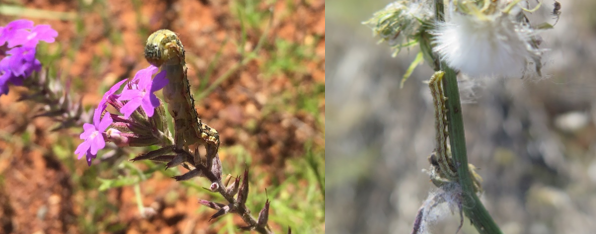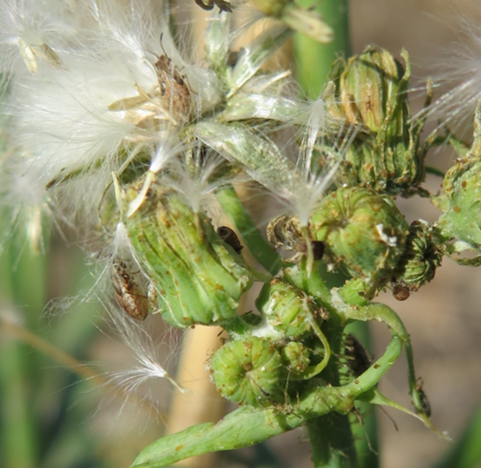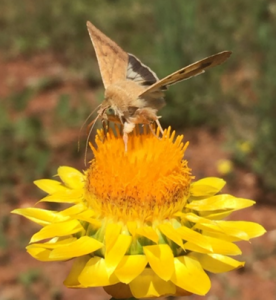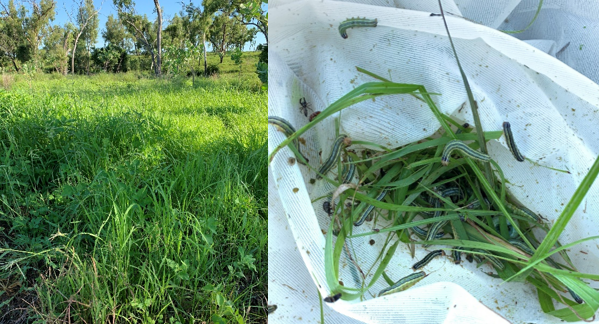Spring has sprung, and as is typical following a wetter winter, insects are abundant in crops. There are native armyworms in winter cereals from Central Queensland to northern NSW. Aphids are abundant in winter cereals, canola and faba beans.
Key drivers of pest abundance in wetter seasons are the increased availability of plant hosts over winter and into spring and the generally warmer temperatures that accompany wet weather. Insects are able to survive in higher numbers through winter when it is warmer, and then build up more quickly from a higher starting population as temperatures increase through spring and summer.
Local pests
Pest species that are resident year-round in cropping regions benefit from the persistent, or early, availability of plant hosts during a wet winter and spring. Commonly referred to as the ‘green bridge’, it is made up of areas outside cropped paddocks (e.g. roadsides, areas of native vegetation) as well as fallows and crops in which weeds (including volunteers from previous crops) may be more abundant in wet seasons.

Helicoverpa larvae on Mayne’s pest and sowthistle
Many pest species are known to benefit from a green bridge and some common examples are listed in Table 1.
Table 1. Invertebrate pest species that build up locally in a wet winter and spring.
| Pest | Examples of known hosts/conditions that favour build up in cropping regions | Crops at risk |
| Aphids | Range of legumes, crucifers (brassicas) and grasses, depending on species | Winter cereals, canola, pulses |
| Bean fly | Early legume weeds | Navy beans, mungbeans |
| Cluster caterpillar | Range of winter and summer crops e.g. pulses, canola, sunflowers, cotton, linseed, lucerne. | Summer pulses, peanuts, cotton, sunflowers |
| Diamond back moth | Cruciferous weeds | Canola |
| Establishment pests (wireworms, false wireworms, earwigs, cockroaches, crickets, scarabs) | Weedy fallows and decomposing stubble encourage survival and build-up of a suite of soil insects | Establishing summer crops e.g. sorghum, maize |
| Etiella | Wattles, wild and cultivated legumes | Summer pulses, peanuts |
| Grain storage pests | Increased survival under higher humidity conditions | All grain in storage |
| Helicoverpa armigera | Wide range of native and exotic broadleaf species | Winter and summer pulses, maize, sorghum, winter cereals, millet, sunflower, canola, safflower |
| Loopers | Year-round soybean plantings in the tropics | Sunflower, summer pulses |
| Native armyworm species | Grasses, winter cereals | Winter cereals, maize |
| Bean pod borer | Sesbania | Mungbeans |
| Podsucking bugs e.g. green vegetable bug | Cruciferous weeds, year-round planting of soybeans in the tropics | Summer pulses |
| Rutherglen bug | Sowthistle, fleabane, pigweed, range of other weed and native species | Canola, sunflower, safflower, summer pulses, sorghum |
| Sorghum midge | First generation of the season occurs in Johnson grass | sorghum |
| Slugs | Increased survival in moist soils | all establishing crops |
| Thrips | A range of flowering weeds and native plants | Establishing summer pulses |
| Yellow peach moth | Maize volunteers | Maize, sorghum, mungbeans (where intercropped with maize) |

Ruthergen bugs on sowthistle
Migratory pests

Helicoverpa punctigera moth visiting wildflower near St George
Not all the key pest species of crops build up in and around cropping areas. If you are in a region that has not been particularly wet over winter, you may still see an increase in the activity of some key species this spring-summer. Native armyworm species, and Helicoverpa punctigera (native budworm) are two species that are well known to breed up in the inland and migrate into eastern cropping regions in spring.
A list of the major pest species that migrate into eastern cropping regions from sources in western and northern Qld are presented in Table 2. Some, like mirids and Rutherglen bug (RGB), may also persist and build locally when conditions are suitable. In 2016 for example, the extraordinary RGB pressure experienced was likely a result of both local build up and immigration occurring.
Native armyworm species outbreaks tend to occur in wet seasons following a drought. It is thought that the drought impacts natural enemies in the source areas, allowing the armyworm numbers to explode on the abundant hosts.

Sweep net collection of native armyworm from grasses near Georgetown
Table 2. Migrant pest species that build up in a wet winter-spring.
| Pest | Examples of known hosts/conditions that favour build up in source regions |
| Green mirids | Native wildflowers and herbs |
| Helicoverpa punctigera
(native budworm) |
Wide range of native species e.g. wildflowers |
| Locusts and grasshoppers | Range of native grasses and broadleaf herbs |
| Native armyworm
e.g. common armyworm |
Native grasses |
| Rutherglen bug | Unknown |
There are additional drivers that determine how severe outbreaks of migrant species will be in any season – a build-up in source regions alone is not enough. In combination with the build-up, there needs to be a subsequent deterioration in the quality or availability of hosts in the source regions (as it gets hotter and drier in spring), plus suitable meteorological conditions that transport the insects into cropping regions.
And it’s not just pests…
Predators and parasitoids are also likely to be active earlier and in higher numbers following a wet winter and spring. They too are advantaged by warmer temperatures and an early availability of prey/hosts. With the outbreak of native armyworm in winter cereals, we can expect to see early activity of parasitoid wasps like Cotesia in summer crops. Cotesia will parasitise several caterpillar pests, including fall armyworm and helicoverpa.
In wetter seasons, diseases (fungi, NPV, bacteria, nematodes) are also likely to be prevalent. Moist conditions favour many of these, and rain splash helps to spread them from the soil onto plants, and around the plant from infected individuals.
